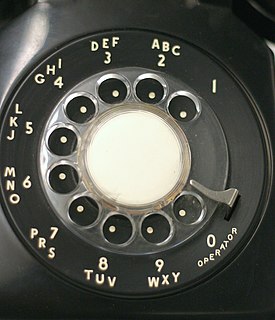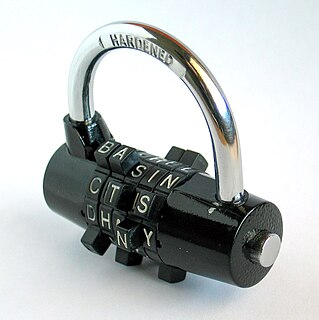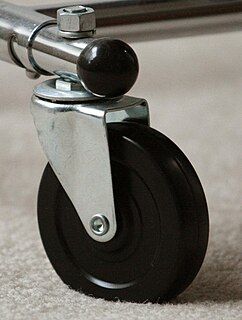
A rotary combination lock is a lock commonly used to secure safes and as an unkeyed padlock mechanism. This type of locking mechanism consists of a single dial which must be rotated left and right in a certain combination in order to open the lock.

A rotary combination lock is a lock commonly used to secure safes and as an unkeyed padlock mechanism. This type of locking mechanism consists of a single dial which must be rotated left and right in a certain combination in order to open the lock.

An externally-accessible dial is manipulated to release the shackle of a padlock or a lock bolt securing a door. The dial is connected to an internal mechanism, usually containing three separate wheels with notches, called gates. Each wheel must be aligned to allow a fence to drop into the gates, releasing the lever that holds the lock in place, allowing the lock to open. Generally, this is accomplished by moving the dial to three (or more) positions, usually denoted by numbers, in a specific sequence of alternating clockwise and anti-clockwise turns. [1] : 2
The wheels are generally arranged in a stacked wheel pack sharing a single axis of rotation, and the individual rotary position of each wheel can be manipulated by turning the dial left and right. The dial is mechanically connected via its spindle to a cam that is equipped with a drive pin — a sort of nub — that can engage a corresponding small catch (known as a fly) on the side of the closest wheel facing the cam; the fly either can be fixed or move within a limited range. [1] : 5–6 On the opposite face of that closest first wheel is another drive pin, which can engage a fly on the side of the second wheel (next-closest to the cam) that is facing the first wheel. Similarly, the second wheel has another drive pin on its opposite face that can engage a fly on the third wheel. Many combination locks have three wheels, but the lock may be equipped with additional wheels, each with a drive pin and fly, in a similar manner. The number of wheels in the mechanism determines the number of specific dial positions that must be entered to open the lock, so a three-sequence combination is required for a three-wheel lock.
As the dial rotates, there will not be enough space for the drive pin on the cam to pass the fly on that face of the first wheel closest to the cam, and so the first wheel will begin to rotate with the dial once the drive pin on the cam engages the fly of the first wheel. The first wheel (closest to the cam) is said to be picked up when this occurs. As this first wheel rotates, its drive pin will in turn engage the fly on the second wheel and the second wheel will begin rotating with the dial and the closest wheel in a similar fashion. Once all wheels are "picked up" and rotating together with the dial, the dial is rotated until the first position/number of the combination is indicated, which means the wheel furthest from the cam is in place and its gate is aligned under the fence. The number of wheels also determines the number of rotations past the first position required to reset the lock; since picking up all the wheels requires a number of rotations equal to the number of wheels, the final wheel (furthest from the cam) cannot be not picked up and positioned until the minimum number of rotations is completed.
After the furthest wheel is positioned, by reversing the rotation of the dial, all the drive pins and flys disengage; as the dial continues to rotate in the opposite direction, the cam will again "pick up" the wheels in sequence (starting from the first wheel, closest to the cam) until all the wheels (save the wheel furthest from the cam) rotate together. In this way, the remaining wheels are rotated without disturbing the alignment of the furthest wheel. Once the second position/number is indicated, the next-to-furthest wheel is in place and its gate is properly aligned with the fence. The rotation of the dial is then reversed again until the remaining wheels are picked up and the gate of the next wheel is aligned with the fence. In this way, by turning the dial back and forth to the correct sequence of positions, all the wheels will be aligned with their gates positioned under the fence.
Once the gates are aligned on all the wheels, the fence drops into the gates, allowing the nose of the lever to engage with a corresponding gate in the cam. Further rotation of the dial moves the lever, retracting the locking mechanism and opening the lock.
Wheels are typically made of a three-layer sandwich. The outer layers, known as the wheel case, contain the gate and surround the externally-toothed wheel center, change key cam, and lever arms. When a change key is inserted into the lock mechanism, it forces apart the lever arms, which then permits the wheel center to rotate freely. This in turn allows the owner to set a custom combination. [1] : 3–4, 6
Some rotary combination locks include internal relockers or relocking devices that separately lock the shackle or bolt when an attack is detected, including mechanical levers that respond to attempts to dislodge the locking mechanism ("punching"), thermal (fusible) links that melt in response to a cutting attempt, or tempered glass that breaks in response to a drilling attempt.
Wheels may be made of radiotransparent materials such as Nylon, Lexan, or Delrin to prevent the use of X-ray imaging to determine the wheel position and required combination. [1] : 5–6

A clutch is a mechanical device that engages and disengages power transmission, especially from a drive shaft to a driven shaft. In the simplest application, clutches connect and disconnect two rotating shafts. In these devices, one shaft is typically attached to an engine and other to power unit, while the other shaft provides output power for work. Typically the motions involved are rotary, but linear clutches also exist.

A rotary dial is a component of a telephone or a telephone switchboard that implements a signaling technology in telecommunications known as pulse dialing. It is used when initiating a telephone call to transmit the destination telephone number to a telephone exchange.

A cam is a rotating or sliding piece in a mechanical linkage used especially in transforming rotary motion into linear motion. It is often a part of a rotating wheel or shaft that strikes a lever at one or more points on its circular path. The cam can be a simple tooth, as is used to deliver pulses of power to a steam hammer, for example, or an eccentric disc or other shape that produces a smooth reciprocating motion in the follower, which is a lever making contact with the cam. A cam timer is similar, and were widely used for electric machine control before the advent of inexpensive electronics, microcontrollers, integrated circuits, programmable logic controllers and digital control.

A differential is a gear train with three shafts that has the property that the rotational speed of one shaft is the average of the speeds of the others, or a fixed multiple of that average.

A disc tumbler or disc detainer lock is a lock composed of slotted rotating detainer discs. The lock was invented by Finnish founder of Abloy, Emil Henriksson (1886–1959) in 1907 and first manufactured under the Abloy brand in 1918.

A combination lock is a type of locking device in which a sequence of symbols, usually numbers, is used to open the lock. The sequence may be entered using a single rotating dial which interacts with several discs or cams, by using a set of several rotating discs with inscribed symbols which directly interact with the locking mechanism, or through an electronic or mechanical keypad. Types range from inexpensive three-digit luggage locks to high-security safes. Unlike ordinary padlocks, combination locks do not use keys.

Mechanical toys are toys powered by mechanical energy. Depending on the mechanism used they can perform a range of motions, from simple to very complex.

A lock is a mechanical or electronic fastening device that is released by a physical object, by supplying secret information, or by a combination thereof or only being able to be opened from one side such as a door chain.

A parking pawl is a device fitted to a motor vehicle's automatic transmission that locks up the transmission when the transmission shift lever selector is placed in the Park position. "Park" is the first position of the lever in all cars sold in the United States since 1965 through SAE J915, and in most other vehicles worldwide.

In cryptography, the M-209, designated CSP-1500 by the United States Navy is a portable, mechanical cipher machine used by the US military primarily in World War II, though it remained in active use through the Korean War. The M-209 was designed by Swedish cryptographer Boris Hagelin in response to a request for such a portable cipher machine, and was an improvement of an earlier machine, the C-36.

A lever tumbler lock is a type of lock that uses a set of levers to prevent the bolt from moving in the lock. In the simplest form of these, lifting the tumbler above a certain height will allow the bolt to slide past.

The Geneva drive or Maltese cross is a gear mechanism that translates a continuous rotation movement into intermittent rotary motion.

A caster is an undriven wheel that is designed to be attached to the bottom of a larger object to enable that object to be moved.

Safe-cracking is the process of opening a safe without either the combination or the key.

A breechblock is the part of the firearm action that closes the breech of a breech loading weapon before or at the moment of firing. It seals the breech and contains the pressure generated by the ignited propellant. Retracting the breechblock allows the chamber to be loaded with a cartridge.

The lever escapement, invented by British clockmaker Thomas Mudge in 1754, is a type of escapement that is used in almost all mechanical watches, as well as small mechanical non-pendulum clocks, alarm clocks, and kitchen timers.

A striking clock is a clock that sounds the hours audibly on a bell or gong. In 12-hour striking, used most commonly in striking clocks today, the clock strikes once at 1:00 A.M., twice at 2:00 A.M., continuing in this way up to twelve times at 12:00 mid-day, then starts again, striking once at 1:00 P.M., twice at 2:00 P.M., up to twelve times at 12:00 midnight.

Padlocks are portable locks with a shackle that may be passed through an opening to prevent use, theft, vandalism or harm.

A latch or catch is a type of mechanical fastener that joins two objects or surfaces while allowing for their regular separation. A latch typically engages another piece of hardware on the other mounting surface. Depending upon the type and design of the latch, this engaged bit of hardware may be known as a keeper or strike.

A mechanical watch is a watch that uses a clockwork mechanism to measure the passage of time, as opposed to quartz watches which function electronically via a small battery, or radio watches, which are quartz watches synchronized to an atomic clock via radio waves. A mechanical watch is driven by a mainspring which must be wound either periodically by hand or via a self-winding mechanism. Its force is transmitted through a series of gears to power the balance wheel, a weighted wheel which oscillates back and forth at a constant rate. A device called an escapement releases the watch's wheels to move forward a small amount with each swing of the balance wheel, moving the watch's hands forward at a constant rate. The escapement is what makes the 'ticking' sound which is heard in an operating mechanical watch. Mechanical watches evolved in Europe in the 17th century from spring powered clocks, which appeared in the 15th century.